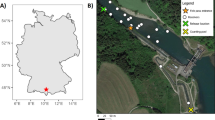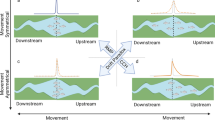Abstract
Restoration of river connectivity favors the spread of native but also of exotic invasive populations, mainly freshwater fish. This has rarely been studied, and never between migrating cyprinids. To harmonize both objectives, the feasibility of a selective leaping barrier for migratory cyprinids is studied through the measurement of fish leaping capabilities while freely migrating at a weir in the Guadiana River of southwest Spain. A cross-population analysis provided the cost-benefit outcomes of completely blocking the invasive Carassius auratus while allowing negotiation for most of the native Luciobarbus sp. populations. Larger fish reached higher leap heights, the highest being attained by the native barbel species. Barbels reached up to four times its total length and a maximum height of approximately 150 cm, while the figures for the invasive goldfish were double total length with a maximum of approximately 80 cm. The selective obstacle height (SOH) for goldfish was 81.2 cm, the estimated maximum height that the tip of a jumping goldfish could reach. Facility designs (whether culvert, weir or fish pass) with this SOH criterion guarantees complete migration failure of goldfish. Also, most (95–99%) of the barbels migrating populations will surpass the SOH regardless of body length; only the less capable or those in poor condition will be blocked. Advice on SOH utility to evaluate existing instream structures—and their position within the cost-benefit balance—is provided.



Similar content being viewed by others
References
Bestgen KR, Mefford B, Bundy JM, Walford CD, Compton RI (2010) Swimming performance and fishway model passage success of Rio Grande silvery minnow. Trans Am Fish Soc 139:433–448
Bonn A, Schröder B (2001) Habitat models and their transfer for single and multi species groups: a case study of carabids in an alluvial forest. Ecography 24:483–496
Branco P, Segurado P, Santos JM, Pinheiro P, Ferreira MT (2012) Does longitudinal connectivity loss affect the distribution of freshwater fish? Ecol Eng 48:70–78
Brandt MM, Holloway JP, Myrick CA, Kondratieff MC (2005) Effects of waterfall dimensions and light intensity on age-0 brook trout jumping performance. Trans Am Fish Soc 134:496–502
Bunt CM, Castro-Santos T, Haro A (2012) Performance of fish passage structures at upstream barriers to migrations. River Res Appl 28:457–478
Cabral MJ, Almeida J, Almeida PR, Dellinger T, Ferrand de Almeida N, Oliveira ME, Palmeirim JM, Queiroz AI, Rogado L, Santos-Reis M (eds) (2005) Livro Vermelho dos Vertebrados de Portugal. Instituto de Conservação da Natureza, Lisboa
Clay CH (1995) Design of fishways and other fish facilities. Lewis, Boca Ratón
Dallimer M, King T, Atkinson RJ (2009) Pervasive threats within a protected area: conserving the endemic birds of São Tomé, West Africa. Anim Conserv 12:209–219
Doadrio I (ed) (2001) Atlas y Libro Rojo de los Peces Continentales de España. Dirección General de Conservación de la Naturaleza, Museo Nacional de Ciencias Naturales, Madrid
Doadrio I, Perea S, Garzón-Heydt P, González JL (2011) Ictiofauna continental española: Bases para su seguimiento. Dirección General de Medio Natural y Política Forestal, Ministerio de Medio Ambiente Rural y Marino, Madrid
Fausch KD, Rieman BE, Dunham JB, Young MK, Peterson DP (2009) Invasion versus isolation: trade-offs in managing native salmonids with barriers to upstream movement. Conserv Biol 23:859–870
Ficke AD, Myrick CA, Jud N (2011) The swimming and jumping ability of three small great Plains fishes: implications for fishway design. Trans Am Fish Soc 140:1521–1531
Gasith A, Resh VH (1999) Streams in Mediterranean climate regions: abiotic influences and biotic responses to predictable seasonal events. Annu Rev Ecol Syst 30:51–81
Geeraerts C, Ovidio M, Verbiest H, Buysse D, Coeck J, Belpaire C, Philippart J-C (2007) Mobility of individual roach Rutilus rutilus (L.) in three weir-fragmented Belgian rivers. Hydrobiologia 582:143–153
GIC (Grupo de Investigación en Biología de la Conservación) (2008) Ictiofauna: efectividad de escalas y movilidad de especies en la cuenca media del Guadiana. Confederación Hidrográfica del Guadiana, Ministerio de Medio Ambiente y Medio Rural y Marino (in Spanish)
Holthe E, Lund E, Finstad B, Thorstad EB, McKinley RS (2005) A fish selective obstacle to prevent dispersion of an unwanted fish species, based on leaping capabilities. Fish Manag Ecol 12:143–147
Katopodis C, Williams JG (2012) The development of fish passage research in a historical context. Ecol Eng 48:8–18
Kondratieff MC, Myrick CA (2005) Two adjustable waterfalls for evaluating fish jumping performance. Trans Am Fish Soc 134:503–508
Kondratieff MC, Myrick CA (2006) How high can brook trout jump? a laboratory evaluation of brook trout jumping performance. Trans Am Fish Soc 135:361–370
Lauritzen DV, Hertel F, Gordon MS (2005) A kinematic examination of wild sockeye salmon jumping up natural waterfalls. J Fish Biol 67:1010–1020
Lauritzen DV, Hertel FS, Jordan LK, Gordon MS (2010) Salmon jumping: behavior, kinematics and optimal conditions, with possible implications for fish passageway design. Bioinspir Biomim 5:035006
Maitland BM, Poesch M, Anderson AE, Pandit SN (2015) Industrial road crossings drive changes in community structure and instream habitat for freshwater fishes in the boreal forest. Freshw Biol 61:1–18
Manly BFJ, McDonald LL, Thomas DL (1993) Resource selection by animals: statistical design and analysis for field studies. Chapman & Hall, London
McDonald DG, Milligan CL, McFarlane WJ, Croke S, Currie S, Hooke B, Angus RB, Tufts BL, Davidson K (1998) Condition and performance of juvenile Atlantic salmon (Salmo salar): effects of rearing practices on hatchery fish and comparison with wild fish. Can J Fish Aquat Sci 55:1208–1219
McLaughlin RL, Smyth ERB, Castro-Santos T, Jones ML, Koops MA, Pratt TC, Vélez-Espino L-A (2013) Unintended consequences and trade-offs of fish passage. Fish Fish 14:580–604
Morán-López R, Da Silva E, Pérez-Bote JL, Corbacho Amado C (2006) Associations between fish assemblages and environmental factors for Mediterranean-type rivers during summer. J Fish Biol 69:1552–1569
Morán-López R, Pérez-Bote JL, Da Silva E, Perales Casildo AB (2012) Hierarchical large-scale to local-scale influence of abiotic factors in summer-fragmented Mediterranean rivers: structuring effects on fish distributions, assemblage composition and species richness. Hydrobiologia 696:137–158
Morán-López R, Sánchez Guzmán JM, Perales Casildo AB, Uceda Tolosa O (2016) Extended negative impact of secondary infrastructure on the high conservation values of sparsely developed areas. Oryx. doi:10.1017/S0030605316000338
Moyle PB, Cech JJ (2004) Fishes: an introduction to ichthyology. Pearson Prentice Hall, Englewood Cliffs
Mueller RP, Southard SS, May CW, Pearson WH, Cullinan VI (2008) Juvenile coho salmon leaping ability and behavior in an experimental culvert test bed. Trans Am Fish Soc 137:941–950
Mueller M, Pander J, Geist J (2011) The effects of weirs on structural stream habitat and biological communities. J Appl Ecol 48:1450–1461
Noatch MR, Suski CD (2012) Non-physical barriers to deter fish movements. Environ Rev 20:71–82
Nooman MJ, Grant JWA, Jackson CD (2012) A quantitative assessment of fish passage efficiency. Fish Fish 12:450–464
Northcote TG (2010) Controls for trout and char migratory/resident behavior mainly in stream systems above and below waterfalls/barriers: a multidecadal and broad geographical review. Ecol Freshw Fish 19:487–509
Ombredane D, Fontenelle G, Ohresser H, Rochedpeau S (1987) Dam overpassing by migratory adult salmonids: an analysis of the leaping behavior with the view of a better management. BFPP Bull Fr Peche Prot Milieux Aquat 305:67–80
Ovidio M, Philippart J-C (2002) The impact of small physical obstacles on upstream movements of six species of fish. Hydrobiologia 483:55–69
Ovidio M, Capra H, Philipart J-C (2007) Field protocol for assessing small obstacles to migration of brown trout Salmo trutta, and European grayling Thymallus thymallus: a contribution to the management of free movement in rivers. Fish Manag Ecol 14:41–50
Pedersen LF, Koed A, Malte H (2008) Swimming performance of wild and F1-hatchery-reared Atlantic salmon (Salmo salar) and brown trout (Salmo trutta). Ecol Freshw Fish 17:425–431
Powers PD, Osborn JF (1985) Analysis of barriers to upstream fish migration: an investigation of the physical and biological conditions affecting fish passage success at culverts and waterfalls. US Department of Energy, Boneville Power Administration, Division of Fish and Wildlife, Final Project Report Part 4 of 4 n DOE/BP-36523-1, Project No. 198201400
Rahel FJ (2013) Intentional fragmentation as a management strategy in aquatic systems. Bioscience 63:362–372
Reiser DW, Huang C-M, Beck S, Gagner M, Jeanes E (2006) Defining flow windows for upstream passage of adult anadromous salmonids at cascades and falls. Trans Am Fish Soc 135:668–679
Roscoe DW, Hinch SG (2010) Effectiveness monitoring of fish passage facilities: historical trends, geographic patterns and future directions. Fish Fish 11:12–33
Royal Decree 630/2013 (2013) Por el que se regula el Catálogo español de especies exóticas invasoras, Ministerio de Agricultura, Alimentación y Medio Ambiente, BOE núm. 185, pp 56764–56786
Sabater S, Muñoz I, Feio MJ, Romaní AM, Graça MAS (2009) The Iberian rivers. In: Tockner K, Robinson CT, Uehlinger U (eds) Rivers of Europe. Academic Press, London, pp 113–149
Schneider CA, Rasband WS, Eliceiri KW (2012) NIH image to ImageJ: 25 years of image analysis. Nat Methods 9:671–675
Schwenk WS, Donovan TM (2011) A multispecies framework for landscape conservation planning. Conserv Biol 25:1010–1021
Shih AM, Techet AH (2010) Characterization of the jumping behavior of archer fish, Toxotes Microlepis. In: 6th world congress of biomechanics (WCB 2010). Singapore, 1–6 Aug, pp 48–51
Stuart IG, Williams A, McKenzie J, Holt T (2006) Managing a migratory pest species: a selective trap for common carp. N Am J Fish Manag 26:888–893
Vélez-Espino LA, McLaughlin RL, Jones ML, Pratt TC (2011) Demographic analysis of trade-offs with deliberate fragmentation of streams: control of invasive species versus protection of native species. Biol Conserv 144:1068–1080
von Brandt A (1984) Fish catching methods of the world, 3rd edn. Fishing News Books, Farnham
Xenopoulos MA, Lodge DM, Alcamo J, Märker M, Schulze K, Van Vuuren DP (2005) Scenarios of freshwater fish extinctions from climate change and water withdrawal. Glob Change Biol 11:1557–1564
Acknowledgements
Christopher Myrick and three anonymous referees provided useful comments to the manuscript.
Author information
Authors and Affiliations
Corresponding author
Ethics declarations
Conflict of interest
The authors declare that they have no conflict of interest.
Rights and permissions
About this article
Cite this article
Morán-López, R., Uceda Tolosa, O. Relative leaping abilities of native versus invasive cyprinids as criteria for selective barrier design. Biol Invasions 19, 1243–1253 (2017). https://doi.org/10.1007/s10530-016-1328-6
Received:
Accepted:
Published:
Issue Date:
DOI: https://doi.org/10.1007/s10530-016-1328-6




